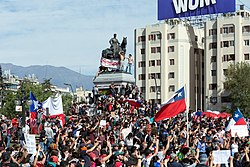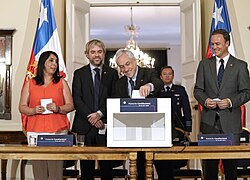2019–2022 Chilean protests
Many civil protests against poverty are taking place in several cities in Chile. The protests began in the capital Santiago as a campaign by secondary school students to avoid paying the Metro de Santiago subway in response to recent price hikes, leading to multiple takeovers of the city's main train stations.
| 2019—20 Chilean protests | |||
|---|---|---|---|
| Part of 2019 Latin American protests and the Latin American Spring | |||
 Protests in Plaza Baquedano, downtown Santiago | |||
| Date | 14 October 2019 – 18 March 2022[1] (6 years, 40 days) | ||
| Location | |||
| Caused by | |||
| Goals |
| ||
| Methods | Protests, fare evasion, civil disobedience, rioting | ||
| Status | Ongoing
| ||
| Parties to the civil conflict | |||
| Lead figures | |||
| |||
| Number | |||
| Casualties | |||
| Death(s) | Possibly 26 | ||
| Injuries | 11,564 | ||
| Arrested | 7259[8] (as of 27 November 2019) | ||
| Detained | ~6,362 people | ||
This had led to open confrontations with the national police (Carabineros).
On 18 October, the situation escalated as organized bands of protesters rose in rebellion across the city, taking control of many terminals of the Santiago Metro network (part of Red) and disabling them with extensive infrastructure damage. The Metro network was disabled in its entirety.
On 18 October, President of Chile Sebastián Piñera announced a state of emergency, sending Chilean Army forces across the main regions to enforce order and crack down on the destruction of public property because of privatization.
A curfew was declared on 19 October in the Greater Santiago area,[9] for the first time since 1987, at the end of the Pinochet dictatorship.[10]
2019–2022 Chilean Protests Media
President Piñera with Minister Alberto Espina and the head of National Defense for the Metropolitan Region Javier Iturriaga del Campo.
Demonstration and barricades in downtown Concepción on 21 October
Protesters in Plaza Baquedano on 22 October
President Piñera summons the Constitutional Plebiscite of 2020.
Poster of the Negro Matapacos dog symbol of social protests in Chile.
Comedian Stefan Kramer performing the "Primera Línea" at the Festival de Viña 2020, where he was harshly criticized by right-wing politicians for "praising and idealizing" violence.
References
- ↑ Cooperativa.cl. "[Video] Secundarios protestaron contra el alza del Metro con masiva evasión" [Secondary [students] protest against the rise of Metro fares with a massive [fare] evasion]. Cooperativa.cl (in español). Archived from the original on 19 October 2019. Retrieved 19 October 2019.
- ↑ 2.0 2.1 CNN, Claudia Dominguez and Daniel Silva Fernandez (19 October 2019). "Chile's president declares state of emergency after riots over metro fare hike". CNN. Archived from the original on 19 October 2019. Retrieved 19 October 2019.
{{cite web}}:|last1=has generic name (help) - ↑ Chile's capital in state of emergency amid unrest. 19 October 2019. https://www.bbc.com/news/world-latin-america-50106743. Retrieved 19 October 2019.
- ↑ "Se filtró un audio de la primera dama de Chile: "Es como una invasión extranjera, alienígena"". Archived from the original on 23 October 2019. Retrieved 23 October 2019.
- ↑ ¡Cambio radical! Sebastián Piñera retrocede ante protestas y anuncia paquete de medidas sociales. 23 October 2019. https://rpp.pe/mundo/chile/sebastian-pinera-retrocede-ante-protestas-y-anuncia-paquete-de-medidas-sociales-noticia-1226067. Retrieved 23 October 2019.
- ↑ Press, Europa (2019-11-13). "Las autoridades chilenas estiman que 3,7 millones de personas participaron en alguna de las protestas". europapress.es. Retrieved 2019-11-13.
- ↑ Cooperativa.cl. "Más de 3,7 millones de personas han asistido a manifestaciones durante la crisis, según Carabineros". Cooperativa.cl (in español). Retrieved 2019-11-13.
- ↑ Frances Jenner (27 November 2019). "Excessive police violence in protests cause deaths and thousands of injuries". Retrieved 29 November 2019.
- ↑ "General Iturriaga decreta toque de queda en Santiago para afrontar graves disturbios". BioBioChile - La Red de Prensa Más Grande de Chile. 2019-10-19. Retrieved 2019-10-20.
- ↑ "Decretan inédito toque de queda en Santiago tras fracaso del gobierno en contener ola de protestas". El Desconcierto (in español). Archived from the original on 2019-10-20. Retrieved 2019-10-20.








